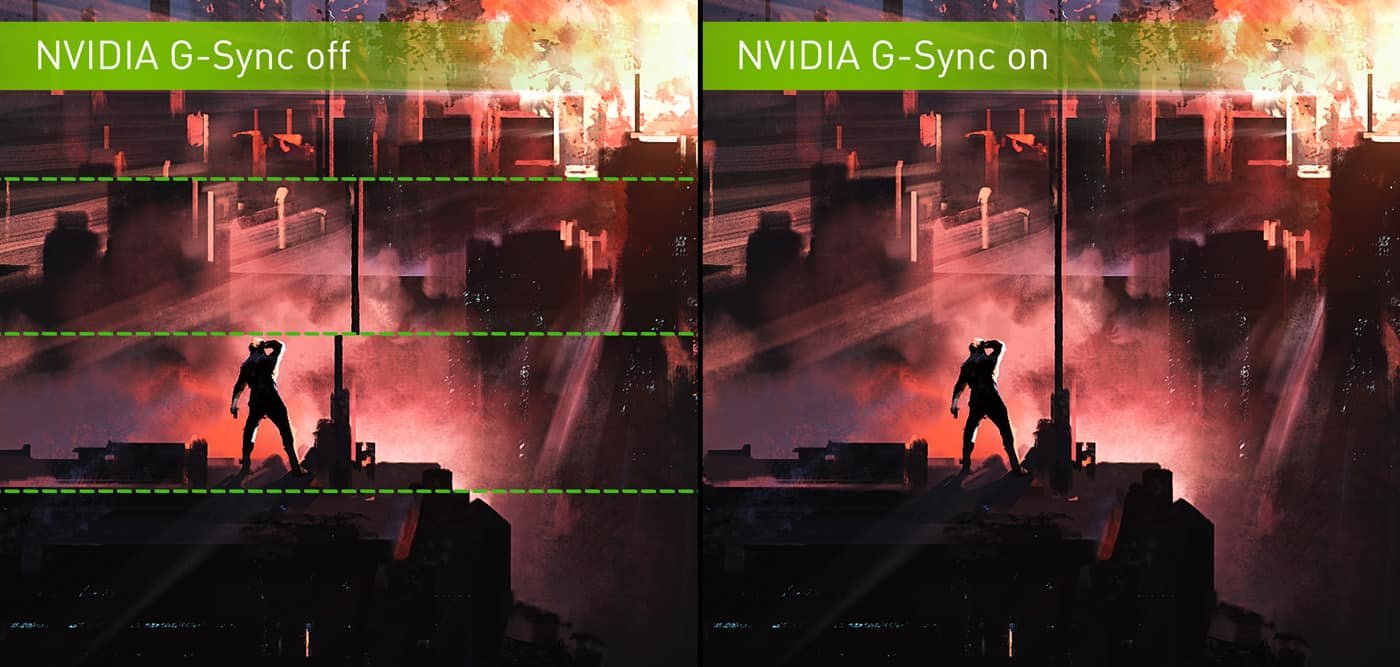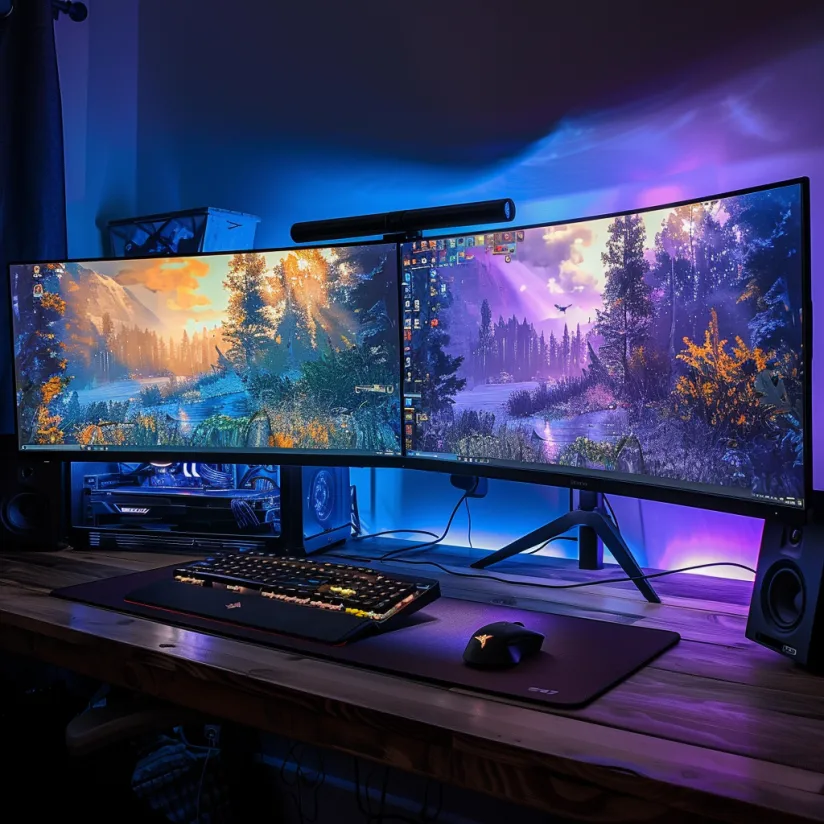If you’ve been shopping for a new gaming monitor, chances are you’ve seen labels like “G-Sync Compatible” or “FreeSync Premium” listed front and center. And while they might sound like just another spec, the difference between G-Sync vs FreeSync can have a real impact on your gaming experience.
Both technologies aim to eliminate screen tearing and stuttering, but they go about it differently. In this guide, we’ll break down how they work, compare their strengths and weaknesses, and help you decide which one fits your setup best.
What Is Adaptive Sync — and Why It Matters
Before we compare FreeSync vs G-Sync, it’s important to understand what adaptive sync actually is.
When your graphics card sends more frames than your monitor can handle — or fewer than expected — visual artifacts like tearing and stuttering can appear. Adaptive Sync solves this by making the monitor’s refresh rate match your graphics card’s output in real time. The result is smoother, more consistent motion with fewer distractions.
There are several adaptive sync technologies available, but the two dominant ones are:
Let’s look at what sets them apart.
What Is G-Sync?
G-Sync is NVIDIA’s proprietary adaptive sync technology, introduced in 2013. It uses a dedicated hardware module inside the monitor to control and synchronize refresh rates with the GPU.

When G-Sync is active, the monitor dynamically adjusts its refresh rate based on the frame rate the GPU is delivering — whether it’s 50 FPS, 100 FPS, or anything in between. This prevents screen tearing and significantly reduces stutter, even in demanding games.
Key Benefits of G-Sync:
- Eliminates screen tearing
- Smooths out inconsistent frame delivery
- Works best with NVIDIA GPUs
- G-Sync Ultimate adds HDR support and 4K@144Hz options
“If you want consistent smoothness with no tearing and minimal stutter, G-Sync is as premium as it gets.”
That premium experience comes at a cost: G-Sync monitors are typically more expensive because of the built-in module. You’ll also want a graphics card with DisplayPort output and full G-Sync support to unlock every feature.
What Is FreeSync?
AMD FreeSync, released in 2015, offers similar benefits but with a different approach. Instead of specialized hardware, FreeSync relies on the VESA Adaptive-Sync standard built into DisplayPort and certain HDMI versions.

Because FreeSync is open and royalty-free, it’s far cheaper for monitor makers to include — and those savings get passed on to you.

Key Benefits of FreeSync:
- Very wide range of compatible monitors
- Generally more affordable than G-Sync
- Works with AMD GPUs (and many NVIDIA cards via Adaptive Sync)
- Higher tiers (Premium / Premium Pro) add LFC and HDR-related features
FreeSync tiers at a glance:
- FreeSync: Core adaptive sync
- FreeSync Premium: Adds Low Framerate Compensation (LFC)
- FreeSync Premium Pro: Adds HDR tone mapping and low-latency modes
AMD FreeSync vs NVIDIA G-Sync: Core Differences
| Feature | FreeSync | G-Sync |
|---|---|---|
| Hardware module | No | Yes |
| Price range | More affordable | More expensive |
| GPU compatibility | AMD (plus many NVIDIA via Adaptive Sync) | NVIDIA only |
| HDR support | FreeSync Premium Pro | G-Sync Ultimate |
| Input lag | Low | Extremely low |
| Ghosting risk | Higher on some budget panels | Minimal |
| Available over HDMI | Yes | Partial (not all models) |
If you’re comparing AMD FreeSync vs NVIDIA G-Sync side by side, the biggest trade-off is price vs consistency. G-Sync monitors offer tighter control and generally better motion handling, especially in high-motion scenes. FreeSync monitors deliver excellent value — particularly if you’re not chasing esports-level perfection.
FreeSync Premium vs G-Sync: HDR, LFC, and Performance Tiers
As monitors improved and games grew more demanding, both AMD and NVIDIA introduced higher tiers. FreeSync Premium/Premium Pro promise smoother performance at low framerates (via LFC), HDR tone mapping, and reduced latency.

G-Sync Ultimate follows a similar path, pairing HDR support with high-end panels (often 4K) that deliver exceptional color and brightness.
In practice, the monitor’s panel quality often matters more than the label. Two HDR-capable monitors can perform very differently regardless of whether they’re FreeSync Premium Pro or G-Sync Ultimate. Check detailed reviews for the specific model you’re considering.
Is G-Sync the Same as G-Sync Compatible?
Not quite. Native G-Sync monitors include an NVIDIA hardware module that tightly controls refresh behavior. G-Sync Compatible monitors don’t have the module; they use Adaptive Sync and have passed NVIDIA’s validation.

These displays still reduce tearing and stutter, but the experience may be less tightly controlled than native G-Sync — especially around refresh range and flicker resistance. For most users, though, G-Sync Compatible provides excellent results at a lower price, especially if you already own an NVIDIA GPU.
FreeSync vs G-Sync vs Adaptive Sync
Here’s the naming simplified:
- Adaptive Sync is the open VESA standard.
- FreeSync is AMD’s implementation of Adaptive Sync.
- G-Sync Compatible is NVIDIA’s validation of Adaptive Sync monitors.
- G-Sync (native) adds NVIDIA’s hardware module for extra control.
All three target the same goal: keep the display in step with the GPU. Differences come down to branding, hardware approach, validation, and overall panel quality.
For the average gamer, it often matters less whether you use FreeSync or G-Sync — and more how well the specific monitor handles variable refresh under load.
Console Support and Cross-Platform Compatibility
If you play on console and PC, compatibility matters. Xbox Series X|S supports both FreeSync and HDMI Forum VRR, giving you plenty of options. PS5 supports HDMI Forum VRR only, so not every FreeSync monitor will fully work the same way.

Native G-Sync monitors typically don’t support VRR on consoles because their module is geared toward DisplayPort/PC use. For dual-purpose setups, FreeSync/HDMI VRR monitors are usually more flexible.
Final Verdict: G-Sync vs FreeSync
If you’re on an NVIDIA GPU and want the smoothest, most tightly controlled motion, a native G-Sync monitor is a strong choice — though you’ll pay more. If you want excellent results without the premium price, FreeSync monitors — especially Premium or Premium Pro — offer outstanding value.
With modern NVIDIA cards supporting Adaptive Sync on many FreeSync displays, the lines have blurred. You no longer need to match brand for brand. Choose based on the monitor’s overall performance (panel quality, HDR, color accuracy, input lag), not just the sync badge.
In the end, both G-Sync and FreeSync solve tearing and reduce stutter. The right pick depends on your GPU, target resolution/refresh rate, budget, and whether HDR and console VRR support matter to you.